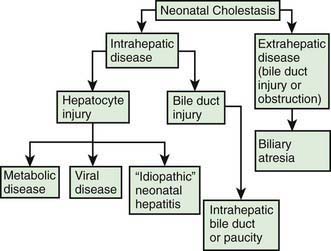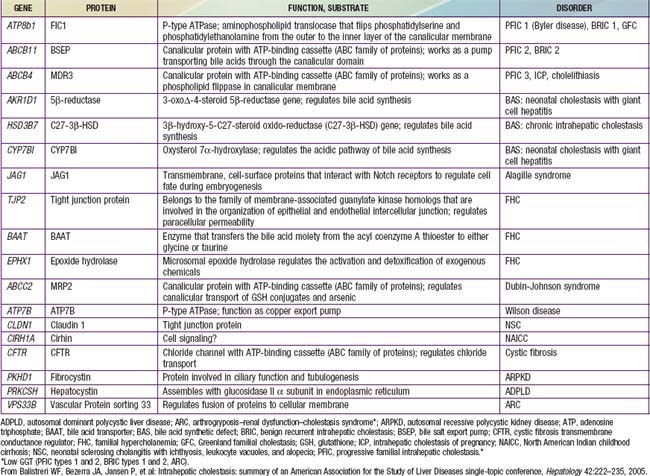Chapter 348 Cholestasis
348.1 Neonatal Cholestasis
H. Hesham A-kader and William F. Balistreri
Neonatal cholestasis is defined biochemically as prolonged elevation of the serum levels of conjugated bilirubin beyond the 1st 14 days of life. Jaundice that appears after 2 wk of age, progresses after this time, or does not resolve at this time should be evaluated and a conjugated bilirubin level determined. Cholestasis in a newborn can be due to infectious, genetic, metabolic, or undefined abnormalities giving rise to mechanical obstruction of bile flow or to functional impairment of hepatic excretory function and bile secretion (see Table 347-3). Mechanical lesions include stricture or obstruction of the common bile duct; biliary atresia is the prototypic obstructive abnormality. Functional impairment of bile secretion can result from congenital defects or damage to liver cells or to the biliary secretory apparatus.
Neonatal cholestasis can be divided into extrahepatic and intrahepatic disease (Fig. 348-1). The clinical features of any form of cholestasis are similar. In an affected neonate, the diagnosis of certain entities, such as galactosemia, sepsis, or hypothyroidism, is relatively simple and a part of most neonatal screening programs. In most cases, the cause of cholestasis is more obscure. Differentiation among biliary atresia, idiopathic neonatal hepatitis, and intrahepatic cholestasis is particularly difficult.

Figure 348-1 Neonatal cholestasis. Conceptual approach to the group of diseases presenting as cholestasis in the neonate. There are areas of overlap: patients with biliary atresia might have some degree of intrahepatic injury. Patients with “idiopathic” neonatal hepatitis might, in the future, be determined to have a primary metabolic or viral disease.
Mechanisms
Metabolic liver disease caused by inborn errors of bile acid metabolism or transport is associated with accumulation of atypical toxic primitive bile acids and failure to produce normal choleretic and trophic bile acids. The clinical and histologic manifestations are nonspecific and are similar to those in other forms of neonatal hepatobiliary injury. Autoimmune mechanisms may also be responsible for some of the enigmatic forms of neonatal liver injury.
Some of the histologic manifestations of hepatic injury in early life are not seen in older patients. Giant cell transformation of hepatocytes occurs commonly in infants with cholestasis and can occur in any form of neonatal liver injury. It is more common and more severe in intrahepatic forms of cholestasis. The clinical and histologic findings that exist in patients with neonatal hepatitis and in those with biliary atresia are quite disparate; the basic process is an undefined initiating insult causing inflammation of the liver cells or of the cells within the biliary tract. If bile duct epithelium is the predominant site of disease, cholangitis can result and lead to progressive sclerosis and narrowing of the biliary tree, the ultimate state being complete obliteration (biliary atresia). Injury to liver cells can present the clinical and histologic picture of “neonatal hepatitis.” This concept does not account for the precise mechanism, but it offers an explanation for well-documented cases of unexpected postnatal evolution of these disease processes; infants initially regarded as having neonatal hepatitis, with a patent biliary system shown on cholangiography, can later develop biliary atresia.
Functional abnormalities in the generation of bile flow can also have a role in neonatal cholestasis. Bile flow is directly dependent on effective hepatic bile acid excretion by the hepatocytes. During the phase of relatively inefficient liver cell transport and metabolism of bile acids in early life, minor degrees of hepatic injury can further decrease bile flow and lead to production of atypical and potentially toxic bile acids. Selective impairment of a single step in the series of events involved in hepatic excretion produces the full expression of a cholestatic syndrome. Specific defects in bile acid synthesis are found in infants with various forms of intrahepatic cholestasis (Table 348-1). Severe forms of familial cholestasis have been associated with neonatal hemochromatosis and an aberration in the contractile proteins that compose the cytoskeleton of the hepatocyte. Neonatal hemochromatosis can also be an alloimmune-mediated gestational (maternal antibodies against fetal hepatocytes) disease responsive to maternal intravenous immunoglobulin (IVIG). Sepsis is known to cause cholestasis, presumably mediated by an endotoxin produced by Escherichia coli.
Table 348-1 PROPOSED SUBTYPES OF INTRAHEPATIC CHOLESTASIS
Note: FIC1 deficiency, BSEP deficiency, and some of the disorders of bile acid biosynthesis are characterized clinically by low levels of serum GGT despite the presence of cholestasis. In all other disorders listed, the serum GGT level is elevated.
ADPLD, autosomal dominant polycystic liver disease (cysts in liver only); ARPKD, autosomal recessive polycystic kidney disease (cysts in liver and kidney); BAAT, bile acid transporter; BRIC, benign recurrent intrahepatic cholestasis; BSEP, bile salt export pump in; GGT, γ-glutamyl transpeptidase; PFIC, progressive familial intrahepatic cholestasis.
From Balistreri WF, Bezerra JA, Jansen P, et al: Intrahepatic cholestasis: summary of an American Association for the Study of Liver Diseases single-topic conference, Hepatology 42:222–235, 2005.
Evaluation
The evaluation of the infant with jaundice should follow a logical, cost-effective sequence in a multistep process (Table 348-2). Although cholestasis in the neonate may be the initial manifestation of numerous and potentially serious disorders, the clinical manifestations are usually similar and provide very few clues about etiology. Affected infants have icterus, dark urine, light or acholic stools, and hepatomegaly, all resulting from decreased bile flow due to either hepatocyte injury or bile duct obstruction. Hepatic synthetic dysfunction can lead to hypoprothrombinemia and bleeding. Administration of vitamin K should be included in the initial treatment of cholestatic infants to prevent hemorrhage.
Table 348-2 VALUE OF SPECIFIC TESTS IN THE EVALUATION OF PATIENTS WITH SUSPECTED NEONATAL CHOLESTASIS
| TEST | RATIONALE |
|---|---|
| Serum bilirubin fractionation (i.e., assessment of the serum level of conjugated bilirubin) | Indicates cholestasis |
| Assessment of stool color (does the baby have pigmented or acholic stools?) | Indicates bile flow into intestine |
| Urine and serum bile acids measurement | Confirms cholestasis; might indicate inborn error of bile acid biosynthesis |
| Hepatic synthetic function (albumin, coagulation profile) | Indicates severity of hepatic dysfunction |
| α1-Antitrypsin phenotype | Suggests (or excludes) PiZZ |
| Thyroxine and TSH | Suggests (or excludes) endocrinopathy |
| Sweat chloride and mutation analysis | Suggests (or excludes) cystic fibrosis |
| Urine and serum amino acids and urine reducing substances | Suggests (or excludes) metabolic liver disease |
| Ultrasonography | Suggests (or excludes) choledochal cyst; might detect the triangular cord (TC) sign, suggesting biliary atresia |
| Hepatobiliary scintigraphy | Documents bile duct patency or obstruction |
| Liver biopsy | Distinguishes biliary atresia; suggests alternative diagnosis |
PiZZ, protease inhibitor ZZ phenotype; TSH, thyroid-stimulating hormone.
In contrast to unconjugated hyperbilirubinemia, which can be physiologic, cholestasis (conjugated bilirubin elevation of any degree) in the neonate is always pathologic and prompt differentiation is imperative. Thus the initial step is to identify the infant who has cholestasis. The next step is to recognize conditions that cause cholestasis and for which specific therapy is available to prevent further damage and avoid long-term complications such as sepsis, an endocrinopathy (hypothyroidism, panhypopituitarism), nutritional hepatotoxicity caused by a specific metabolic illness (galactosemia), or other metabolic diseases (tyrosinemia).
Hepatobiliary disease can be the initial manifestation of homozygous α1-antitrypsin deficiency or of cystic fibrosis. Neonatal liver disease can also be associated with congenital syphilis and specific viral infections, notably echovirus and herpesviruses including cytomegalovirus (CMV). These account for a small percentage of cases of neonatal hepatitis syndrome The hepatitis viruses (A, B, C) rarely cause neonatal cholestasis.
The final and critical step in evaluating neonates with cholestasis is to differentiate extrahepatic biliary atresia from neonatal hepatitis.
Intrahepatic Cholestasis
Neonatal Hepatitis
The term neonatal hepatitis implies intrahepatic cholestasis (see Fig. 348-1), which has various forms (Tables 348-1 and 348-3).
Idiopathic neonatal hepatitis, which can occur in either a sporadic or a familial form, is a disease of unknown cause. Patients with the sporadic form presumably have a specific yet undefined metabolic or viral disease. Familial forms, on the other hand, presumably reflect a genetic or metabolic aberration; in the past, patients with α1-antitrypsin deficiency were included in this category.
Aagenaes syndrome is a form of idiopathic familial intrahepatic cholestasis associated with lymphedema of the lower extremities. The relationship between liver disease and lymphedema is not understood and may be attributable to decreased hepatic lymph flow or hepatic lymphatic hypoplasia. Affected patients usually present with episodic cholestasis with elevation of serum aminotransferases, alkaline phosphatase, and bile acids. Between episodes, the patients are usually asymptomatic and biochemical indices improve. Compared to other types of hereditary neonatal cholestasis, patients with Aagenaes syndrome have a relatively good prognosis because >50% can expect a normal life span. The locus for Aagenaes syndrome is mapped to a 6.6cM interval on chromosome 15q.
Zellweger (cerebrohepatorenal) syndrome is a rare autosomal recessive genetic disorder marked by progressive degeneration of the liver and kidneys (Chapter 80.2). The incidence is estimated to be 1/100,000 births; the disease is usually fatal in 6-12 mo. Affected infants have severe, generalized hypotonia and markedly impaired neurologic function with psychomotor retardation. Patients have an abnormal head shape and unusual facies, hepatomegaly, renal cortical cysts, stippled calcifications of the patellas and greater trochanter, and ocular abnormalities. Hepatic cells on ultrastructural examination show an absence of peroxisomes. MRI performed in the 3rd trimester can allow analysis of cerebral gyration and myelination, facilitating the prenatal diagnosis of Zellweger syndrome.
Neonatal hemochromatosis seems to be a gestational alloimmune disease, and reoccurrence of severe neonatal hemochromatosis in at-risk pregnancies may be reduced by maternal treatment with weekly (beginning gestational age 18 wk) high-dose IVIG (1 g/kg) during gestation. After birth, affected neonates are treated with exchange transfusions and IVIG (1 g/kg), which improves survival and reduces the need for liver transplantation.
Disorders of Transport, Secretion, Conjugation, and Biosynthesis of Bile Acids
Progressive familial intrahepatic cholestasis type 1 (PFIC 1) or FIC1 disease (formerly known as Byler disease) is a severe form of intrahepatic cholestasis. The disease was initially described in the Amish kindred of Jacob Byler. Affected patients present with steatorrhea, pruritus, vitamin D–deficient rickets, gradually developing cirrhosis, and low γ-glutamyl transpeptidase (GGT) levels. The absence of bile duct paucity and extrahepatic features differentiate this disorder from Alagille syndrome.
PFIC 1 (FIC-1 deficiency) has been mapped to chromosome 18q12 and results from defect in the gene for F1C1 (ATP8B1; Tables 348-3 and 348-4). F1C1 is a P-type adenosine triphosphatase (ATPase) that functions as aminophospholipid flippase, facilitating the transfer of phosphatidyl serine and phosphatidyl ethanolamine from the outer to inner hemileaflet of the cellular membrane. F1C1 might also play a role in intestinal bile acid absorption, as suggested by the high level of expression in the intestine. Defective F1C1 might also result in another form of intrahepatic cholestasis: benign recurrent intrahepatic cholestasis (BRIC) type I. The disease is characterized by recurrent bouts of cholestasis, jaundice, and severe pruritus lasting from a 2 wk to 6 mo period; it can last up to 5 yr. The episodes vary from few episodes per year to 1 episode per decade and can profoundly affect the quality of life. Nonsense, frame shift, and deletional mutations cause PFIC type I; missense and split type mutations result in BRIC type I. Typically, patients with BRIC type I have normal cholesterol and GGT levels.

Full access? Get Clinical Tree



